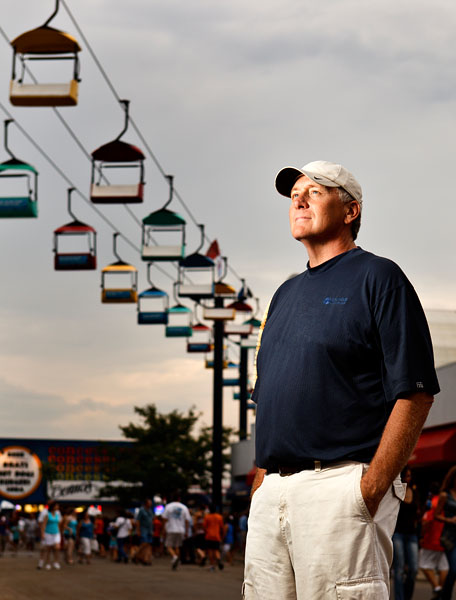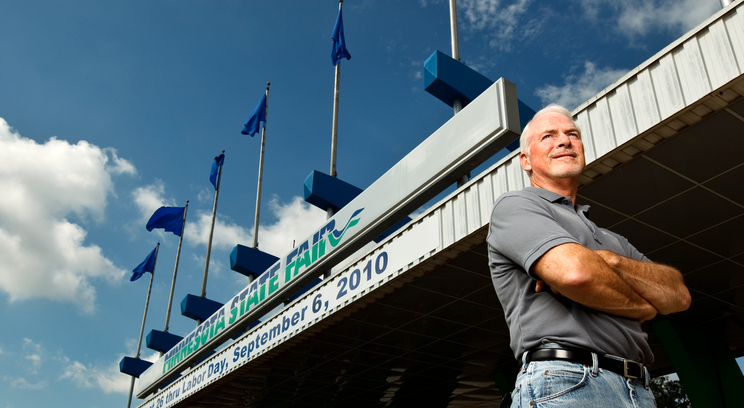As summer inches its way past the spring thaw each year, it brings welcome memories of longer days, shorter shorts and, for many in this region, anticipation of the summertime event affectionately and simply referred to as “the fair."
Jerry Hammer’s earliest recollection of the fair is fleeing from it when he was three years old. “We were watching a [midway attraction] … where a man sits in a cage, and a light bulb above his head turns off. When it turns back on, there [was] a guy in a gorilla suit standing in the cage where the man used to be.”
Terrified, Hammer (above) grabbed his parents’ hands and ran directly home – two blocks away from the Minnesota State Fair’s main gates on Breda Avenue in St. Paul.
“I remember looking out the window to see if the gorilla was chasing us home. … My 6-year-old brother [Robert ’74] just laughed.”
For Rick Frenette, the initial fair experience was decidedly less eventful. He remembers just the “smell of foods and carnival rides.” Of course, having been born into and raised on fair culture – his father, Don, was part owner of the Northern Wisconsin State Fair in Chippewa Falls – state fair quirks were as familiar to him as cornfields.
Frenette's father, whom he calls “an entrepreneurial spirit,” also owned a handful of restaurants and concession stands. Frenette’s first job, at age 12, was running the family’s Pronto Pup stand at the fair, where he’d often work 15-hour days.
Hammer eventually got over his initial fair scare, landing a landscaping job at the Minnesota State Fair when he was 15. “There weren’t many 15-year-old kids getting full-time work and only day hours [for their summer jobs],” he said, grateful.
Hammer’s work at the fair proved even more portentous the summer after he graduated from St. Thomas. A journalism major, Hammer wasn’t in a hurry to leap onto a career path. He was content to spend another summer working at the fair while figuring out where to go from there.
“[Journalism Department Chair] Father Whalen saw a photo of me in the paper trimming a topiary replica of the Liberty Bell and asked what I was doing [still working at the fair]” he recalls.
Soon after, with Whalen’s help, Hammer obtained his first job – and what would become his only job outside of the Minnesota State Fair since graduating from St. Thomas – as a sports editor at the Owatonna People’s Press.
But by the winter of 1977, after a year of working at the paper, homesickness set in. Hammer then approached Mike Heffron ’57, the general manager of the fair, “who took a chance on me,” he said. Heffron put Hammer to work full time on “non-fair events,” (other events held on the fairgrounds). It was a sort of homecoming, and “I will always be grateful to him,” Hammer noted.
Although Hammer didn’t know it at the time, Heffron’s gesture kick-started his lifelong career at the Minnesota State Fair. A career that eventually would take him to the top of the fair food chain. Before long, Hammer began working in the publicity department –performing simple tasks such as writing newsletters – before he was promoted to publicity superintendent. He held the superintendent position until Heffron announced his retirement in January 1996. That month, Hammer was rewarded for his nearly 20 years of dedication to the fair by accepting the general manager position. The rest, as they say, is history.

Rick Frenette. (Photo by Mike Ekern '02)
Frenette, on the other hand, followed a peripatetic course, but said he wouldn’t have had it any other way. “My kids both work in Hollywood now, and I don’t think they would’ve had the courage to do so if I had stayed in Wisconsin.”
He worked at his father’s fair during summers off from high school and college at the University of Wisconsin – Eau Claire. (He spent his first semester freshman year at St. Thomas in fall 1970.).
He also did some part-time work at the fair through the mid-’80s. Frenette later crossed the border to get his M.B.A. from St. Thomas and worked gate operations at the Minnesota State Fair, where he met Hammer.
Of their close working friendship, Frenette said, “We share everything because we’re not in competition with each other.” Hammer concurs, citing a “unique [working] environment” in which “you want to see everyone succeed,” a quality absent from many professions. The two even bounce ideas off each other from time to time, they said.
Within a couple years at the Minnesota State Fair, Frenette was promoted to finance director. Hammer was marketing director at the time. By the early ’90s, Frenette wanted a new challenge and set his sights on a general manager position, but at Minnesota, “there were others [like Jerry] who had more seniority and experience than I had,” he said, so he knew he’d soon have to move on.
Frenette’s career path ferried him to fairs outside the Midwest. In 1993, he was hired to lead the Ohio State Fair, “where you couldn’t sell a deep-fried cheese curd if you tried,” he said. Then in 2004 he headed west to Salt Lake City to run the show at the Utah State Fair where, he said, “they love desserts on a stick” but don’t share the gargantuan appetites for super-sized, artery-clogging food that Minnesotans and Wisconsinites relish.
Frenette said both Minnesota and Wisconsin are “eating fairs,” and fairgoers spend more on food than at most fairs across the country.
While Hammer worked his way up the ladder at the Minnesota State Fair over two decades, Frenette moved among three states over 25 years, working as general manager at two fairs. Now 57, Frenette is in the midst of planning his first year (he began in January) as executive director of the Wisconsin State Fair in West Allis, Wis. It was the only position that could have lured him away from Utah, he said. Excited to be back in his home state, he added, “It would be my dream [to retire here].”
When asked about their goals as the heads of two large, Midwestern state fairs, it is clear that Frenette and Hammer take their responsibilities to their communities seriously.
Both cited, independently, the need to honor their respective fair’s roots – agriculture, education and youth and family-oriented activities – while keeping them relevant. In fact, Hammer keeps a button on his desk that reads “Because I’ve always done it that way.” A thick, red slash runs diagonally across the phrase. Years ago, a staff member found it on the street and gave it to him because it reminded him of Hammer’s work ethic. “You can’t stand still,” he chimed in. “How many times have you heard, ‘Well, we’ve always done it that way’? Well, I don’t want to hear that.”
Frenette said during fair time, he is “continually moving around and witnessing what people are experiencing” and taking notes. He also requires his office staff to do the same and report back to him.
Same goes for Hammer, who admitted that despite all his eating on job (he counts footlong hot dogs as his favorite), he loses 10 pounds during the fair because he is constantly on the move.
These longtime friends consider themselves lucky to be running two of the most popular state fairs in the country. As for who has the best food-on-a-stick? They’ll leave that rivalry to the hundreds of thousands of satisfied fairgoers who pass through their gates every August.
Read more from St. Thomas Magazine.







